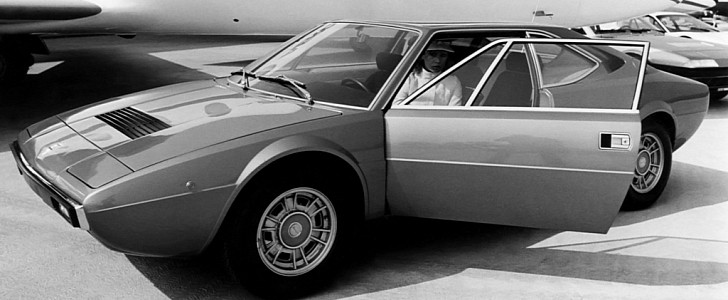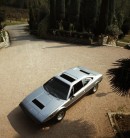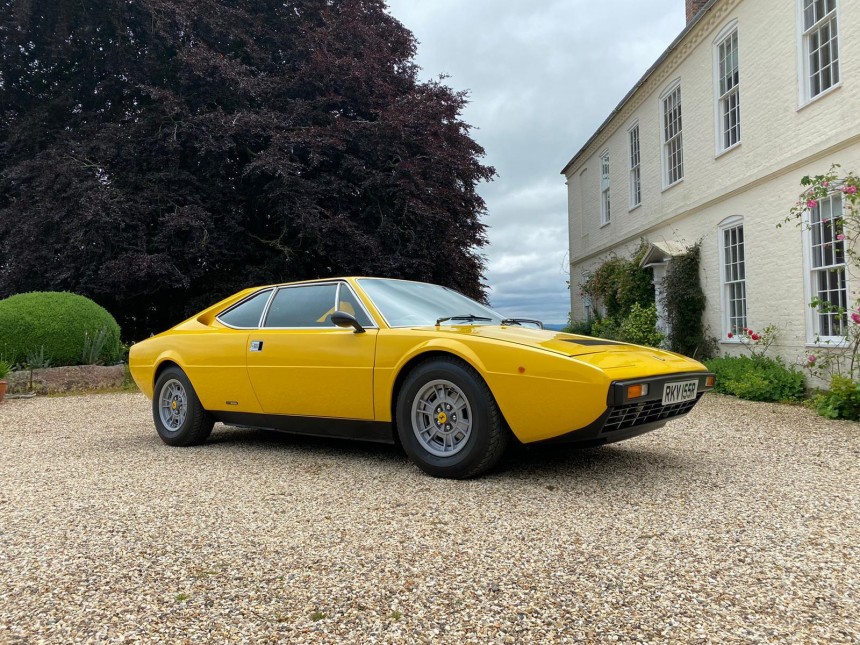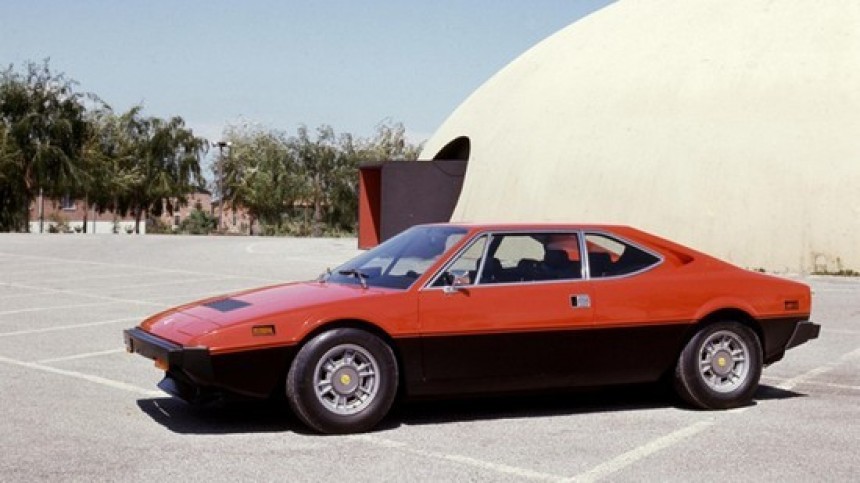Eclipsed by the 308 GTB and 308 GTS, the 308 GT4 brought new customers to the Prancing Horse, peeps that may have originally considered the Porsche 911 or Lamborghini Urraco. This underappreciated classic also marked two firsts for Ferrari: the first series-production car with a V8 and the first mid-engined car with a 2+2 seating layout.
Unveiled in October 1973 at the Paris Motor Show, the GT4 was initially marketed under the Dino sub-brand because the Maranello-based automaker couldn’t imagine a road-going Ferrari with anything other than a V12 under the hood back then. Ferrari retained the Dino branding until May 1976 due to a number of reasons, especially consumer preference in the United States.
A market that Enzo Ferrari had coveted for many years, the U.S. of A. served the GT4 well. Elvis Presley, for instance, purchased a black 1975 model in October 1976. But as you’re well aware, Ferrari didn’t sell many cars in that era. Come December 1980, the assembly line came to a screeching halt after 2,826 examples of the 308 had been built. 547 units were finished in right-hand drive. An extra 840 units were fitted with a low-displacement V8 that we’ll cover a bit later on, bringing the total to 3,666 examples of the GT4.
A brand-new design, the Dino V8 in the GT4 differs from the previous Dino V6 by means of two additional cylinders, a larger displacement, as well as a 90-degree angle between the cylinder banks compared to 65 degrees. Also worthy of note, the 65-degree V12 engine family that premiered in the Ferrari 456 is rocking the same 75-mm stroke as the Dino V8 in the 348.
Sometimes referred to as a 3.0-liter mill, although it actually displaces 2,926 cubic centimeters, the powerplant in the GT4 features the same 81-mm bore and 71-mm stroke as the Colombo V12 in the ultra-collectible 365 series.
Mounted transversally, the 2.9-liter V8 is mated to a five-speed manual transaxle that drives the rear wheels through a limited-slip differential. Rated at 240 horsepower in the U.S. and 255 ponies back home in the Old Continent, this fellow is fed by no fewer than four downdraft carburetors. Two valves per cylinder, belt-driven dual overhead camshafts, wet-sump lubrication, and a pair of Marelli distributors also need to be noted.
Intended for the Italian market where large-displacement engines were - and still are - heavily taxed, the 2.0-liter V8 mentioned a few paragraphs earlier debuted at the 1975 Geneva Motor Show. De-stroked to 66.8 millimeters while retaining the 2.9-liter engine’s 81-mm bore, the low-displacement variant develops 170 metric horsepower. It also features Weber 34 instead of Weber 40 carburetors, skinnier tires, as well as a lower final drive ratio.
Penned by Marcello Gandini, the guy who also gave us the Lamborghini Urraco, the GT4 is the first Bertone-styled Ferrari since 1953. Founded by Giovanni Bertone in 1912, the Turin-based company was contracted for the GT4 because of the Fiat Dino Coupe sketched by Giorgetto Giugiaro for Bertone. What’s more, we also have to remember that Bertone was at the forefront of the coolest 1970s automotive design trend, the wedge design.
Built around a tubular steel chassis derived from that of the 246, the 308 uses square tube subframes and a fair bit of fiberglass. Koni shock absorbers, coil springs, unequal-length wishbones, and two anti-roll bars sum up the suspension system of the GT4 series. Ventilated rotors, a dual-circuit braking system, and 14-inch alloys with chrome hubs are featured as well, along with two fuel tanks mounted on the sides of the V8 against the rear bulkhead.
Bodied in steel and aluminum, the sporty four-seat model brings the point home with two sexy buttresses that incorporate a pair of boomerang-shaped air intakes. The left intake channels the air to the oil radiator, whereas the right intake feeds air to the Weber-sourced downdraft carburetors.
In terms of extras, the options list consisted of goodies such as air conditioning, metallic paint, satin black for the lower half of the body, a sunroof, as well as a rear-seat delete. Slightly updated in July 1975 for the 1976 model year, the GT4 was improved once again in January 1978 with single-distributor electronic ignition. Cars intended for the U.S. market adopted catalytic converters that year, robbing the engine of 35 ponies.
Replaced by the Mondial, the oft-overlooked GT4 still is a relatively affordable classic that’s not particularly expensive to maintain. The biggest issue comes in the guise of the original sodium-filled valves. If they go bad, which is a certainty in the GT4, then prepare yourself for a costly engine rebuild.
A market that Enzo Ferrari had coveted for many years, the U.S. of A. served the GT4 well. Elvis Presley, for instance, purchased a black 1975 model in October 1976. But as you’re well aware, Ferrari didn’t sell many cars in that era. Come December 1980, the assembly line came to a screeching halt after 2,826 examples of the 308 had been built. 547 units were finished in right-hand drive. An extra 840 units were fitted with a low-displacement V8 that we’ll cover a bit later on, bringing the total to 3,666 examples of the GT4.
A brand-new design, the Dino V8 in the GT4 differs from the previous Dino V6 by means of two additional cylinders, a larger displacement, as well as a 90-degree angle between the cylinder banks compared to 65 degrees. Also worthy of note, the 65-degree V12 engine family that premiered in the Ferrari 456 is rocking the same 75-mm stroke as the Dino V8 in the 348.
Sometimes referred to as a 3.0-liter mill, although it actually displaces 2,926 cubic centimeters, the powerplant in the GT4 features the same 81-mm bore and 71-mm stroke as the Colombo V12 in the ultra-collectible 365 series.
Intended for the Italian market where large-displacement engines were - and still are - heavily taxed, the 2.0-liter V8 mentioned a few paragraphs earlier debuted at the 1975 Geneva Motor Show. De-stroked to 66.8 millimeters while retaining the 2.9-liter engine’s 81-mm bore, the low-displacement variant develops 170 metric horsepower. It also features Weber 34 instead of Weber 40 carburetors, skinnier tires, as well as a lower final drive ratio.
Penned by Marcello Gandini, the guy who also gave us the Lamborghini Urraco, the GT4 is the first Bertone-styled Ferrari since 1953. Founded by Giovanni Bertone in 1912, the Turin-based company was contracted for the GT4 because of the Fiat Dino Coupe sketched by Giorgetto Giugiaro for Bertone. What’s more, we also have to remember that Bertone was at the forefront of the coolest 1970s automotive design trend, the wedge design.
Built around a tubular steel chassis derived from that of the 246, the 308 uses square tube subframes and a fair bit of fiberglass. Koni shock absorbers, coil springs, unequal-length wishbones, and two anti-roll bars sum up the suspension system of the GT4 series. Ventilated rotors, a dual-circuit braking system, and 14-inch alloys with chrome hubs are featured as well, along with two fuel tanks mounted on the sides of the V8 against the rear bulkhead.
In terms of extras, the options list consisted of goodies such as air conditioning, metallic paint, satin black for the lower half of the body, a sunroof, as well as a rear-seat delete. Slightly updated in July 1975 for the 1976 model year, the GT4 was improved once again in January 1978 with single-distributor electronic ignition. Cars intended for the U.S. market adopted catalytic converters that year, robbing the engine of 35 ponies.
Replaced by the Mondial, the oft-overlooked GT4 still is a relatively affordable classic that’s not particularly expensive to maintain. The biggest issue comes in the guise of the original sodium-filled valves. If they go bad, which is a certainty in the GT4, then prepare yourself for a costly engine rebuild.


























